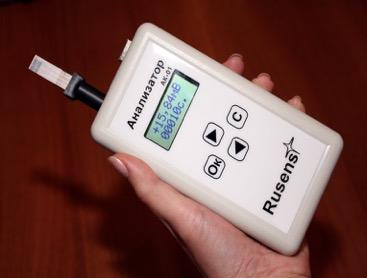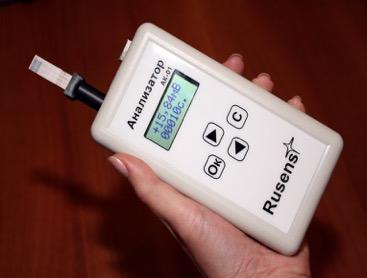
Credit: Vita Nikitina
Scientists from the Faculty of Chemistry of the Lomonosov Moscow State University have elaborated an electrochemical sensor on the basis of polymers with molecular imprinting, aimed at detection of saccharides and hydroxy acids. The researchers have presented the results in the Sensors and Actuators B: Chemical journal.
Chemists from the Electrochemical Methods Laboratory at the Lomonosov Moscow State University under the leadership of Professor Arkady Karyakin, Doctor of Chemistry, have elaborated an enzyme-free sensor, allowing measurement of glucose and lactic acid concentration.
Vita Nikitina, a Junior Researcher at the Faculty of Chemistry of the Lomonosov Moscow State University and one of the project authors, shares: "Many people have heard about glucose meters – devices, detecting glucose in blood. According to the operating principle most of them are electrochemical. This means that glucose concentration is measured in terms of current density, registered with the help of an enzyme electrode – biosensor, going with the device in the form of a testing strip. However, enzyme usage for chemical detection of substances of interest (for instance, the glucose oxidase enzyme is used in case of glucose) in such devices has its disadvantages. These disadvantages are mostly connected with low stability of enzymes and necessity to provide special storage and operating conditions and biosensor disposability."
In their project the chemists from the Lomonosov Moscow State University deal with alternative enzyme-free devices. The sensor, elaborated by the scientists, is an electrode, modified by a thin polymer layer. Such sensors are not only easy to produce, but also more stable in operation and storage. Moreover, reagents for their production are massively cheaper than enzymes.
The project author comments: "In the structure of polymer, synthesized by us on the surface of the electrode, there are functional groups, namely boronic acids, capable of detecting such common low-molecular compounds, like saccharides (glucose and fructose) and hydroxy acids (lactic and tartaric acids). In the project we've shown how our sensors could be used for detection of these substances. A signal, generated by the sensor, is registered by electrochemical means similar to enzyme electrodes. However, unlike amperometric glucose meters, our device is based on another principle – namely, the change of polymer conductivity."
Generation of electrically conductive polymer coating on the surface of electrodes turns out to be a nontrivial task. That's why elaboration and thorough optimization of conditions and parameters of electropolymerization have become an important success of the researchers. Polymers were synthesized under the current action, flowing through the working electrode, placed into an electrochemical cell with monomer solution. As a result of this electrochemical process the water-insoluble polymer is deposited on the electrode surface.
The chemists have synthesized a polymer with the help of a molecular imprinting method. It implies formation of special regions (imprints) in the material, and these regions recognize only those molecules, which have been used as templates during polymer synthesis. Such materials, possessing molecular memory, could be applied as sensitive layer of chemical sensors, aimed at detection of certain substances. Electrochemical polymerization of substituted aniline was conducted in the presence of template molecules – namely, hydroxy acids and saccharides. After polymerization these molecules were removed from the polymer matrix, however, in its three-dimensional structure some spaces (so called molecular imprints) were left. These imprints in terms of the form, size and orientation of functional groups are complimentary to these template molecules. This effect, called "molecular memory" of a polymer, provides the material with the ability to detect compounds, which have been used as templates.
So, the scientists have got a chemical sensor, made of an electrode, coated by substituted polyaniline with molecular imprints. In order to test the sensor the researchers have placed it into an electrochemical cell, where the analyzed sample is located. If there have been saccharides or hydroxy acids in the analyzed sample, than boronic acid groups of the polymer bind with them, what resulted in the growth of polymer conductivity, which has been registered with the help of an electrochemical impedance spectroscopy technique.
Vita Nikitina says: "We've shown that it's possible to create multisensory systems on the basis of elaborated sensors with different selectivity. These systems allow the monitoring of concentration of various substances in biochemical processes. Such sensors could be used for detection of high-molecular substances and even whole cells, having structural fragments of saccharides or hydroxy acids."
###
Media Contact
Vladimir Koryagin
[email protected]
http://www.msu.ru
############
Story Source: Materials provided by Scienmag





